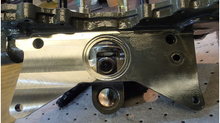SAIB-18-29R1 Rotorcraft Tail Boom, Attach Structure Failure
SUBJ: Rotorcraft Tail Boom, Attach Structure Failure SAIB: SW-18-29R1 Date: February 19, 2019
This is information only. Recommendations aren’t mandatory.
Introduction This Special Airworthiness Information Bulletin (SAIB) alerts owners, operators, and pilots of an airworthiness concern on Restricted Category Bell Model HH-1K, UH-1A, UH-1B, UH-1E, UH-1F, UH-1H, UH-1L, UH-1P, TH-1F, and TH-1L converted from military helicopters.
This airworthiness concern and possible corrective actions are still under investigation and we are considering future Airworthiness Directive (AD) action under 14 CFR part 39. Until such time as we issue an AD, the information and recommendations provided herein are intended to educate and raise awareness of this concern, and to minimize a possible tail boom attach structure failure. This SAIB’s recommended actions may be different from any corrective actions mandated by AD.
We revised this SAIB to: (1) include a recommended minimum amount of paint removal for the cap angles and longerons; (2) clarify paint and sealant removal procedures; and (3) simplify the wording of the recommendations to improve clarity.
Background In January 1982, a tail boom separated from a UH-1B helicopter engaged in logging operations, resulting in a fatal accident. The National Transportation Safety Board’s (NTSB) final report identified structural fatigue and inadequate maintenance as probable causes. In September 2013, a tail boom separated from another UH-1B helicopter engaged in logging operations, resulting in another fatal accident. The NTSB’s final report for that accident identified the cause as fatigue failure of the upper two tail boom attach points. Contributing to this accident was poor maintenance throughout the helicopter’s operational life.
In addition to these accidents, the FAA is aware of three forced landings due to tail boom attach structure failures, one in May 2014, one in August 2016, and one in August 2018. The helicopter involved in the May 2014 forced landing was engaged in construction operations. The helicopter involved in the August 2018 forced landing was engaged in firefighting operations. In the first fatal accident and two of the forced landings, a loud pop or bang was heard in the rear of the aircraft at the moment of failure. In the second fatal accident, the pilot indicated before the flight that the helicopter felt like it “shuffled” during translational lift. Four of these incidents involved a failure of the upper left hand tail boom attach structure. In three cases it was the attach fitting on the tail boom side. In one case it was the longeron on the tail boom side. The upper left hand tail boom attach point is the most heavily loaded of the four attach points.
Recommendations The FAA recommends all owners and operators of the helicopters listed in the Introduction section of this SAIB strictly adhere to the applicable Instructions for Continued Airworthiness which require repetitive 100 flight hour inspections. The 100-hour inspection requires inspection of all tail boom attach structure (four locations, both fuselage and tail boom side) for cracks, bond separation, corrosion, damage and the attach bolts for security. We further recommend the following procedures to supplement the Instructions for Continued Airworthiness.
Remove paint and stray sealant and clean the attach fittings (tail boom and fuselage side). Remove paint and stray sealant and clean the cap angles, forward of the fuselage fittings, and the longerons, aft of the tail boom fittings, for at least 4 inches beyond the end of the fittings. It is only necessary to remove the topcoat; primer may be left in place and edge and fillet sealant may be left in place. Reapply any removed primer and edge and fillet sealant following the inspection.
Use a borescope to inspect the visible surfaces of the attach structure. A borescope facilitates a closer examination, as the tail boom side structure is difficult to access. The upper right hand tail boom side attach fitting is located behind a tail rotor pitch control rod. On the fuselage side, particular attention should be given to the fitting section through the rivets closest to the attach bolt, and the cap angle and cap angle rivets next to the fitting, as failures in these areas are more common. On the tail boom side, particular attention should be given to the fitting section through the rivets closest to the attach bolt, as failures in this area are more common. Smoking rivets are also an indicator of attach point issues.
For helicopters which engage in heavy lift operations, we also recommend the upper left hand attach fittings, cap angle, and longeron be inspected every 20 flight hours per the procedures in the preceding paragraph. The upper left hand attach structure is the most critical as it is subjected to the heaviest loads.
Finally, if a loud noise (typically a “pop” or “bang”) is heard in the rear of the aircraft during flight, we recommend minimizing hovering, slow flight, and pedal turns; reducing power when possible to avoid left pedal input; jettisoning external loads (if present) as soon as possible; and landing the helicopter as soon as possible. If an external load must be landed, perform a forward descent until load touches down.
For Further Information Contact Richard Thomas, Aviation Safety Engineer, Denver ACO Branch, East 68th Avenue, Room 214, Denver, Colorado 80249; phone 303-342-1085; fax 303-342-1088; e-mail richard.r.thomas@faa.gov. If Mr. Thomas is unavailable, please contact the Denver ACO Branch directly; office phone 303-342-1080; email 9-Denver-Aircraft-Cert@faa.gov.
For Related Service Information Contact The attachment below contains restricted category type certificate (TC) holder contact information. For surrendered TCs, contact the cognizant ACO Branch or the Aviation Safety Engineer listed above.



































